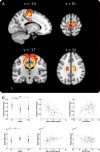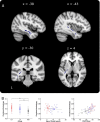Early musical training and white-matter plasticity in the corpus callosum: evidence for a sensitive period
- PMID: 23325263
- PMCID: PMC6704889
- DOI: 10.1523/JNEUROSCI.3578-12.2013
Early musical training and white-matter plasticity in the corpus callosum: evidence for a sensitive period
Abstract
Training during a sensitive period in development may have greater effects on brain structure and behavior than training later in life. Musicians are an excellent model for investigating sensitive periods because training starts early and can be quantified. Previous studies suggested that early training might be related to greater amounts of white matter in the corpus callosum, but did not control for length of training or identify behavioral correlates of structural change. The current study compared white-matter organization using diffusion tensor imaging in early- and late-trained musicians matched for years of training and experience. We found that early-trained musicians had greater connectivity in the posterior midbody/isthmus of the corpus callosum and that fractional anisotropy in this region was related to age of onset of training and sensorimotor synchronization performance. We propose that training before the age of 7 years results in changes in white-matter connectivity that may serve as a scaffold upon which ongoing experience can build.
Figures




Similar articles
-
Differences in white matter architecture between musicians and non-musicians: a diffusion tensor imaging study.Neurosci Lett. 2002 Mar 15;321(1-2):57-60. doi: 10.1016/s0304-3940(02)00054-x. Neurosci Lett. 2002. PMID: 11872256
-
White matter plasticity in the corticospinal tract of musicians: a diffusion tensor imaging study.Neuroimage. 2009 Jul 1;46(3):600-7. doi: 10.1016/j.neuroimage.2009.02.025. Epub 2009 Mar 3. Neuroimage. 2009. PMID: 19264144
-
Training of working memory impacts structural connectivity.J Neurosci. 2010 Mar 3;30(9):3297-303. doi: 10.1523/JNEUROSCI.4611-09.2010. J Neurosci. 2010. PMID: 20203189 Free PMC article.
-
Sensitive periods in human development: evidence from musical training.Cortex. 2011 Oct;47(9):1126-37. doi: 10.1016/j.cortex.2011.05.010. Epub 2011 May 17. Cortex. 2011. PMID: 21665201 Review.
-
Brain Plasticity and the Concept of Metaplasticity in Skilled Musicians.Adv Exp Med Biol. 2016;957:197-208. doi: 10.1007/978-3-319-47313-0_11. Adv Exp Med Biol. 2016. PMID: 28035567 Review.
Cited by
-
White matter and neurological disorders.Arch Pharm Res. 2020 Sep;43(9):920-931. doi: 10.1007/s12272-020-01270-x. Epub 2020 Sep 25. Arch Pharm Res. 2020. PMID: 32975736 Review.
-
Differences in Cortical Representation and Structural Connectivity of Hands and Feet between Professional Handball Players and Ballet Dancers.Neural Plast. 2016;2016:6817397. doi: 10.1155/2016/6817397. Epub 2016 May 9. Neural Plast. 2016. PMID: 27247805 Free PMC article.
-
Music literacy improves reading skills via bilateral orthographic development.Sci Rep. 2024 Feb 12;14(1):3506. doi: 10.1038/s41598-024-54204-8. Sci Rep. 2024. PMID: 38347056 Free PMC article.
-
Increased structural connectivity of the medial forebrain bundle in schizophrenia spectrum disorders is associated with delusions of paranoid threat and grandiosity.Neuroimage Clin. 2019;24:102044. doi: 10.1016/j.nicl.2019.102044. Epub 2019 Oct 18. Neuroimage Clin. 2019. PMID: 31678911 Free PMC article.
-
Genetic factors and shared environment contribute equally to objective singing ability.iScience. 2022 May 6;25(6):104360. doi: 10.1016/j.isci.2022.104360. eCollection 2022 Jun 17. iScience. 2022. PMID: 35633942 Free PMC article.
References
-
- Amunts K, Schlaug G, Jäncke L, Steinmetz H, Schleicher A, Dabringhaus A, Zilles K. Motor cortex and hand motor skills: structural compliance in the human brain. Hum Brain Mapp. 1997;5:206–215. - PubMed
-
- Bailey J, Penhune VB. A sensitive period for musical training: contributions of age of onset and cognitive abilities. Ann N Y Acad Sci. 2012;1252:163–170. - PubMed
-
- Beaulieu C. The basis of anisotropic water diffusion in the nervous system: a technical review. NMR Biomed. 2002;15:435–455. - PubMed
Publication types
MeSH terms
Grants and funding
LinkOut - more resources
Full Text Sources
Other Literature Sources
